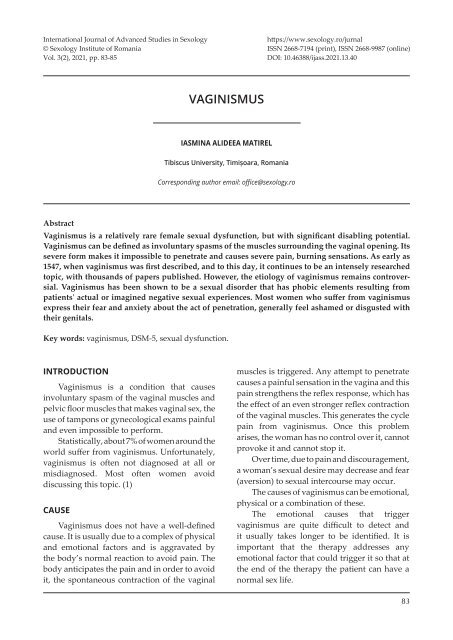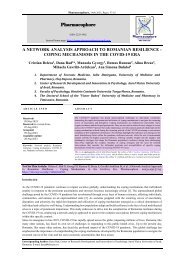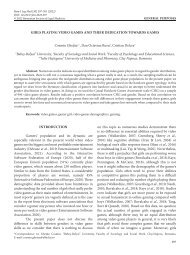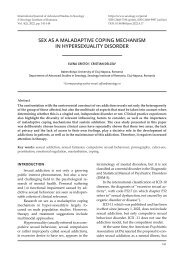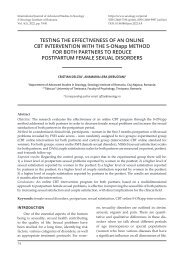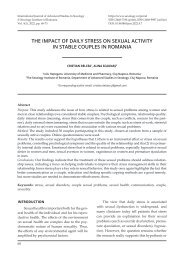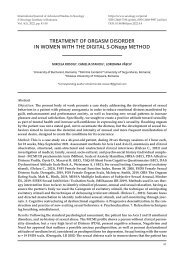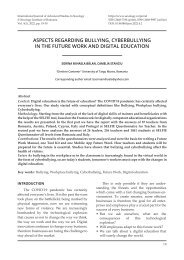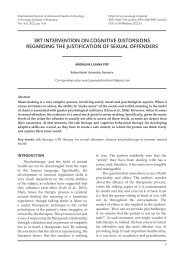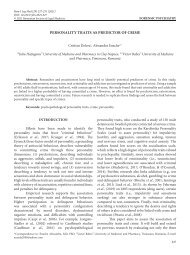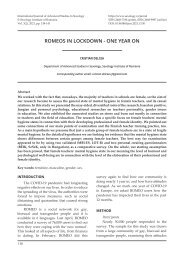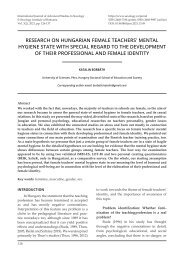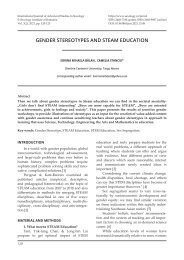Vaginismus
Vaginismus is a relatively rare female sexual dysfunction, but with significant disabling potential. Vaginismus can be defined as involuntary spasms of the muscles surrounding the vaginal opening. Its severe form makes it impossible to penetrate and causes severe pain, burning sensations. As early as 1547, when vaginismus was first described, and to this day, it continues to be an intensely researched topic, with thousands of papers published. However, the etiology of vaginismus remains controversial. Vaginismus has been shown to be a sexual disorder that has phobic elements resulting from patients' actual or imagined negative sexual experiences. Most women who suffer from vaginismus express their fear and anxiety about the act of penetration, generally feel ashamed or disgusted with their genitals. Keywords: vaginismus, DSM-5, sexual dysfunction.
Vaginismus is a relatively rare female sexual dysfunction, but with significant disabling potential. Vaginismus can be defined as involuntary spasms of the muscles surrounding the vaginal opening. Its severe form makes it impossible to penetrate and causes severe pain, burning sensations. As early as 1547, when vaginismus was first described, and to this day, it continues to be an intensely researched topic, with thousands of papers published. However, the etiology of vaginismus remains controversial. Vaginismus has been shown to be a sexual disorder that has phobic elements resulting from patients' actual or imagined negative sexual experiences. Most women who suffer from vaginismus express their fear and anxiety about the act of penetration, generally feel ashamed or disgusted with their genitals.
Keywords: vaginismus, DSM-5, sexual dysfunction.
Create successful ePaper yourself
Turn your PDF publications into a flip-book with our unique Google optimized e-Paper software.
International Journal of Advanced Studies in Sexology<br />
© Sexology Institute of Romania<br />
Vol. 3(2), 2021, pp. 83-85<br />
https://www.sexology.ro/jurnal<br />
ISSN 2668-7194 (print), ISSN 2668-9987 (online)<br />
DOI: 10.46388/ijass.2021.13.40<br />
VAGINISMUS<br />
IASMINA ALIDEEA MATIREL<br />
Tibiscus University, Timișoara, Romania<br />
Corresponding author email: office@sexology.ro<br />
Abstract<br />
<strong>Vaginismus</strong> is a relatively rare female sexual dysfunction, but with significant disabling potential.<br />
<strong>Vaginismus</strong> can be defined as involuntary spasms of the muscles surrounding the vaginal opening. Its<br />
severe form makes it impossible to penetrate and causes severe pain, burning sensations. As early as<br />
1547, when vaginismus was first described, and to this day, it continues to be an intensely researched<br />
topic, with thousands of papers published. However, the etiology of vaginismus remains controversial.<br />
<strong>Vaginismus</strong> has been shown to be a sexual disorder that has phobic elements resulting from<br />
patients' actual or imagined negative sexual experiences. Most women who suffer from vaginismus<br />
express their fear and anxiety about the act of penetration, generally feel ashamed or disgusted with<br />
their genitals.<br />
Key words: vaginismus, DSM-5, sexual dysfunction.<br />
INTRODUCTION<br />
<strong>Vaginismus</strong> is a condition that causes<br />
involuntary spasm of the vaginal muscles and<br />
pelvic floor muscles that makes vaginal sex, the<br />
use of tampons or gynecological exams painful<br />
and even impossible to perform.<br />
Statistically, about 7% of women around the<br />
world suffer from vaginismus. Unfortunately,<br />
vaginismus is often not diagnosed at all or<br />
misdiagnosed. Most often women avoid<br />
discussing this topic. (1)<br />
CAUSE<br />
<strong>Vaginismus</strong> does not have a well-defined<br />
cause. It is usually due to a complex of physical<br />
and emotional factors and is aggravated by<br />
the body’s normal reaction to avoid pain. The<br />
body anticipates the pain and in order to avoid<br />
it, the spontaneous contraction of the vaginal<br />
muscles is triggered. Any attempt to penetrate<br />
causes a painful sensation in the vagina and this<br />
pain strengthens the reflex response, which has<br />
the effect of an even stronger reflex contraction<br />
of the vaginal muscles. This generates the cycle<br />
pain from vaginismus. Once this problem<br />
arises, the woman has no control over it, cannot<br />
provoke it and cannot stop it.<br />
Over time, due to pain and discouragement,<br />
a woman’s sexual desire may decrease and fear<br />
(aversion) to sexual intercourse may occur.<br />
The causes of vaginismus can be emotional,<br />
physical or a combination of these.<br />
The emotional causes that trigger<br />
vaginismus are quite difficult to detect and<br />
it usually takes longer to be identified. It is<br />
important that the therapy addresses any<br />
emotional factor that could trigger it so that at<br />
the end of the therapy the patient can have a<br />
normal sex life.<br />
83
IASMINA ALIDEEA MATIREL<br />
Psychological causes that can cause<br />
vaginismus:<br />
- Childhood experiences - rigid parents, exposure<br />
to shocking sexual images, religious<br />
teachings (“sex is bad”), inadequate sex<br />
education<br />
- Relationship problems - abuse, emotional<br />
detachment, mistrust, anxiety in connection<br />
with the loss of control<br />
- Anxiety or stress - general anxiety, guilt, negativity<br />
about sex, or any unhealthy emotion<br />
- The fear of getting pregnant, the fear of pain,<br />
the fear that a pelvic trauma has not healed.<br />
- Traumatic experiences from the past such<br />
as sexual abuse, rape, physical assault,<br />
repressed memories.<br />
Physical causes can be:<br />
- Changes due to age - menopause and<br />
hormonal changes, inadequate lubrication.<br />
- Medical problems such as urinary tract infection,<br />
fungal infections, endometriosis, STIs,<br />
pelvic inflammatory disease, cancer.<br />
- Postpartum pain, abortion, cesarean section.<br />
- Temporary discomfort caused by too little<br />
lubrication, insufficient prelude.<br />
- Side effects from medications that can cause<br />
pelvic pain. (2)<br />
TYPES OF VAGINISM<br />
Primary vaginismus refers to the situation<br />
where there was never painless sexual<br />
intercourse or sexual intercourse was always<br />
impossible.<br />
Secondary vaginismus refers to the situation<br />
in which after a period of painless sexual<br />
intercourses, pain occurs at penetration. It<br />
usually occurs after an event such as medical<br />
problems, birth, relationship problems, etc.<br />
<strong>Vaginismus</strong> can be generalized or situational.<br />
In the latter case, it will be limited to<br />
certain situations or certain partners.<br />
<strong>Vaginismus</strong> can be exclusively psychogenic<br />
or it can be both psychogenic and organic. (3)<br />
DIAGNOSTIC<br />
The one who makes the diagnosis is the<br />
gynecologist, not everyone has experience<br />
with vaginismus but will be able to rule out<br />
other conditions and help.<br />
The diagnosis is made by a gynecological<br />
examination, the exclusion of other conditions<br />
and by general and reproductive medical<br />
history and description of the problem. (4)<br />
TREATMENT<br />
A pelvic physiotherapist or sexologist may<br />
be contacted for treatment.<br />
The treatment of vaginismus involves a<br />
number of conditions, including:<br />
- Cognitive treatment<br />
- Sex education<br />
- Control of vaginal muscle activity<br />
- Self-exploration of sexual anatomy<br />
- Relaxation control training<br />
- Sharing control with your partner<br />
- Penis interference under the control of the<br />
woman<br />
- Transferring the control of the partner’s<br />
interference<br />
- Exploring phobias (if present).<br />
The average duration of treatment is 20<br />
sessions. The frequency of therapy sessions<br />
varies from one to four hours per week,<br />
depending on the individual needs of the<br />
patient. Intervals between treatment sessions<br />
are needed to get used to and integrate the<br />
changes that have taken place. (5)<br />
The most important variable in determining<br />
a positive evolution is, however, the<br />
support that the woman has during the treatment<br />
in order to be able to control the anxiety<br />
produced by the moment of penetration. The<br />
patient is in the dilemma of following a treatment<br />
that will make her accept the thing she<br />
fears most, that is, penetration. Ideally, this<br />
anxiety should be addressed during couple<br />
therapy so that anxiety does not lead to discontinuation<br />
of treatment or further refusal of<br />
women to accept possible penetration. The<br />
treatment addresses the root causes of vaginismus<br />
and includes a combination of couple<br />
therapy, individual relaxation exercises for<br />
women, couple exercises aimed at increasing<br />
sensitivity.<br />
Because the causes of vaginismus are<br />
predominantly psychological, the principle of<br />
84
<strong>Vaginismus</strong><br />
the therapeutic approach will aim to relax the<br />
patient in order to remove anxiety. The basic<br />
principles of treatment will be the same as for<br />
any other sexual dysfunction: mutual responsibility,<br />
information and education, attitudinal<br />
and behavioral change, elimination of sexual<br />
anxiety, increased level of communication,<br />
changes in the definition of sex roles and lifestyle.<br />
(6)<br />
The cure rate is 80-100%, and it is the<br />
psychosomatic approach that ensures this high<br />
therapeutic success.<br />
CONSEQUENCES OF VAGINISM<br />
Among the consequences of vaginismus I<br />
mention the following: marriage may remain<br />
unconsumed (this may be grounds for divorce),<br />
the husband will be more prone to marital infidelity,<br />
family life will be unhappy, sex will not<br />
be a source of pleasure, inability to have a sex<br />
life will result in a couple without children.<br />
<strong>Vaginismus</strong> makes many women feel<br />
lonely, misunderstood, scared and can affect<br />
their relationships, emotional health and<br />
self-esteem. Some do not understand what<br />
they are going through, others understand but<br />
still cannot get rid of guilt. (7)<br />
CONCLUSION<br />
The first step for any woman who suspects<br />
vaginismus is to schedule a full pelvic exam to<br />
rule out a somatic cause.<br />
<strong>Vaginismus</strong> is most often conceptualized<br />
as a psychosomatic disorder, a physical manifestation<br />
of deeper psychological problems.<br />
There are several theories about the<br />
psychological causes but most of them focus on<br />
the following three aspects: control problems<br />
in the couple, previous sexual traumas, conditional<br />
association of pain/fear with vaginal<br />
penetration (a phobic reaction to the idea of <br />
penetration).<br />
Regardless of the specific cause, there are<br />
two characteristic features of vaginismus: the<br />
inability to have a vaginal penetration and<br />
emotional stress.<br />
BIBLIOGRAPHY<br />
1. Delcea C. (2019). Orgasmic disorder in women.<br />
Int J Advanced Studies in Sexology. Vol. 1, Issue<br />
1, pp. 56-67. Sexology Institute of Romania.<br />
DOI: 10.46388/ijass.2019.12.11.122<br />
2. Pană R. A., (2020). The Female Orgasm<br />
Disorder. An Individual Psychology Approach.<br />
Int J Advanced Studies in Sexology. Vol. 2, Issue<br />
1, pp. 5-8. Sexology Institute of Romania. DOI:<br />
10.46388/ijass.2020.13.11<br />
3. Hajnalka G., (2020). Painful intercourse.<br />
Dyspareunia and <strong>Vaginismus</strong>. An Individual<br />
Psychology Approach. Int J Advanced<br />
Studies in Sexology. Vol. 2, Issue 1, pp. 32-37.<br />
Sexology Institute of Romania. DOI: 10.46388/<br />
ijass.2020.13.16<br />
4. Kocsis A., (2020). Female orgasm disorder.<br />
An Individual Psychology Approach. Int J<br />
Advanced Studies in Sexology. Vol. 2, Issue 1,<br />
pp. 49-53. Sexology Institute of Romania. DOI:<br />
10.46388/10.46388/ijass.2020.13.18<br />
5. Stuparu C., (2020). Female orgasm disorder.<br />
Anorgasmia. Int J Advanced Studies in Sexology.<br />
Vol. 2, Issue 2, pp. 89-93. Sexology Institute of<br />
Romania. DOI: 10.46388/ijass.2020.13.25<br />
6. Lupa M. M., (2020). Dyspareunia. Int J<br />
Advanced Studies in Sexology. Vol. 2, Issue 2,<br />
pp. 98-100. Sexology Institute of Romania. DOI:<br />
10.46388/ijass.2020.13.27<br />
7. Fejza H., Icka E., Fejza F., (2021). <strong>Vaginismus</strong><br />
As A Hidden Problem: Our Case Series. Int J<br />
Advanced Studies in Sexology. Vol. 3, Issue 1,<br />
pp. 5-9. Sexology Institute of Romania. DOI:<br />
10.46388/ijass.2020.13.32<br />
85


